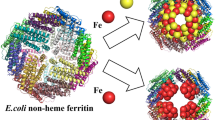Summary
Carboxyl groups present on the outer face of the hexagonally ordered S-layer lattices from Bacillus stearothermophilus PV72 and Clostridium thermohydrosulfuricum L111-69 were activated with carbodiimide. The reaction of the activated carboxyl groups with free amino groups of low molecular weight nucleophiles was controlled by labelling with polycationized ferritin, a net positively charged topographical marker for electron microscopy, which densely binds to S-layers possessing free carboxyl groups. Carbodiimide-activated carboxyl groups were also allowed to react with amino groups of ferritin (MW 440 000) and invertase (MW 270 000). Covalent attachment of ferritin was examined by electron microscopy. Using invertase, approximately 1 mg enzyme was bound per mg S-layer protein indicating a high packing density of invertase molecules on the outer face of the S-layer lattice. The immobilized invertase retained 70% of its original activity.
Similar content being viewed by others
References
Baumeister W, Engelhardt H (1987) Three dimensional structure of bacterial surface layers. In: Harris JR, Horne RW (eds) Electron microscopy of proteins, Vol 6, Academic Press London, pp 109–155
Boitieux J-L, Desmet G, Thomas D (1978) Immobilization of anti HBs Ag antibodies on artificial proteic membranes. FEBS Lett 93:133–136
Coulet PR, Godinot C, Gautheron DC (1975) Surface-bound aspartate aminotransferase on collagen-films. Compared properties with native enzymes. Biochim Biophys Acta 319:272–281
D'Souza SF, Nadkarni NB (1980) Continuous conversion of sucrose to fructose and gluconic acid by immobilized yeast cell multienzyme complex. Biotechnol Bioeng 22:2179–2189
Goldstein A, Lampen O (1975) β-d-Fructofuranoside-fructohydrolase from yeast. Methods Enzymol 42:504
Hahn-Hägerdal B (1982) Co-immobilization involving cell organelles and enzymes. In: Mattiasson B (ed) Immobilized cells and organelles, Vol 2, CRC Press, pp 79–94
Hartmeier W (1983) Preparation, properties and possible application of coimmobilized biocatalysts. In: Lafferty R (ed) Enzyme technology, Springer, Berlin, pp 207–217
Hartmeier W (1987) Coimmobilisierung von ganzen Zellen mit zusätzlichen Enzymen. Biotech-Forum 4:217–223
Karube I, Suzuki S (1972) Electrochemical preparation of urease-collagen membrane. Biochem Biophys Res Comm 47:51–54
Koval SF, Murray RGE (1986) The superficial protein arrays on bacteria. Microbiol Sci 3:357–361
Lowry OH, Rosebrough NJ, Farr AL, Randall RJ (1951) Protein measurement with Folin-phenol reagent. J Biol Chem 193:265–275
Messner P, Pum D, Sleytr UB (1986a) Characterization of the ultrastructure and the self-assembly of the surface layer of Bacillus stearothermophilus NRS 2004/3a. J Ultrastruct Mol Struct Res 97:73–88
Messner P, Pum D, Sára M, Stetter KO, Sleytr UB (1986b) Ultrastructure of the cell envelope of the archaebacteria Thermoproteus tenax and Thermoproteus neutrophilus. J Bacteriol 166:1046–1054
Sára M, Sleytr UB (1987) Molecular-sieving through S-layers of Bacillus stearothermophilus strains. J Bacteriol 169:4092–4098
Sára M, Kalsner I, Sleytr UB (1988) Surface properties from the S-layer of Clostridium thermosaccharolyticum D120-70 and Clostridium thermohydrosulfuricum L111-69. Arch Microbiol 149:527–533
Sleytr UB, Messner P (1983) Crystalline surface layers on bacteria. Ann Rev Microbiol 37:311–339
Sleytr UB, Messner P (1988) Crystalline surface layers in procaryotes. J Bacteriol 170:2891–2897
Sleytr UB, Sára M, Küpcü Z, Messner P (1986) Structural and chemical characterization of S-layers of selected strains of Bacillus stearothermophilus and Desulfotomaculum nigrificans. Arch Microbiol 146:19–24
Smith J (1986) Protein surface layers of bacteria. In: Inouye M (ed) Bacterial outer membranes as model systems. Wiley, New York Chichester Brisbane Toronto Singapore, pp 343–376
Takasaki Y (1976) Method of immobilizing enzymes to microbial cells. US Pat No 3950222
Author information
Authors and Affiliations
Rights and permissions
About this article
Cite this article
Sára, M., Sleytr, U.B. Use of regularly structured bacterial cell envelope layers as matrix for the immobilization of macromolecules. Appl Microbiol Biotechnol 30, 184–189 (1989). https://doi.org/10.1007/BF00264009
Issue Date:
DOI: https://doi.org/10.1007/BF00264009




